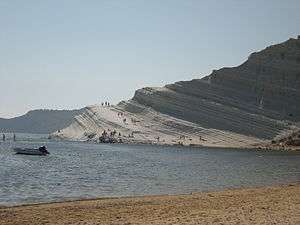Marl

Marl or marlstone is a calcium carbonate or lime-rich mud or mudstone which contains variable amounts of clays and silt. The dominant carbonate mineral in most marls is calcite, but other carbonate minerals such as aragonite, dolomite, and siderite may be present. Marl was originally an old term loosely applied to a variety of materials, most of which occur as loose, earthy deposits consisting chiefly of an intimate mixture of clay and calcium carbonate, formed under freshwater conditions; specifically an earthy substance containing 35–65% clay and 65–35% carbonate.[1] It also describes a habit of coralline red alga.[2] The term is today often used to describe indurated marine deposits and lacustrine (lake) sediments which more accurately should be named 'marlstone'. Marlstone is an indurated (resists crumbling or powdering) rock of about the same composition as marl, more correctly called an earthy or impure argillaceous limestone. It has a blocky subconchoidal fracture, and is less fissile than shale. The term 'marl' is widely used in English-language geology, while the terms Mergel and Seekreide (German for "lake chalk") are used in European references.
The lower stratigraphic units of the chalk cliffs of Dover consist of a sequence of glauconitic marls followed by rhythmically banded limestone and marl layers. Upper Cretaceous cyclic sequences in Germany and marl–opal-rich Tortonian-Messinian strata in the Sorbas basin related to multiple sea drawdown have been correlated with Milankovitch orbital forcing.[3]
Marl as lacustrine sediment is common in postglacial lake-bed sediments, often found underlying peat bogs. It has been used as a soil conditioner and acid soil neutralizing agent.
Types used in agriculture
Marl was extensively mined in Central New Jersey as a soil conditioner in the 1800s. In 1863, the most common marl was blue marl. While the specific composition and properties of the marl varied depending on what layer it was found in, blue marl was generally composed of 38.70% silicic acid and sand, 30.67% oxide of iron, 13.91% carbonate of lime, 11.22% water, 4.47% potash, 1.21% magnesia, 1.14% phosphoric acid, and .31% sulphuric acid.[4]
Marl was in high demand for farms. An example of the amount of marl mined comes from a report from 1880, from Marlboro, Monmouth County, New Jersey, which reported the following tons of marl sold:[5]
- OC Herbert Marl Pit - 9961 tons
- Uriah Smock Marl Pit - 4750 tons
- CM Conover Marl Pit - 760 tons
In the Centennial Exhibition report in 1877, marl is described in many different forms[6] and came from sixty-nine marl pits in and around New Jersey. The report identified a number of agricultural marls types, including clay marl, blue marl, red marl, high bank marl, shell layer marl, under shell layer marl, sand marl, green marl, gray marl, and clayey marl.[7]
See also
References
Citations
- ↑ Pettijohn (1957), p. 410.
- ↑ Steneck, R. S. (1986). "The Ecology of Coralline Algal Crusts: Convergent Patterns and Adaptative Strategies". Annual Review of Ecology and Systematics. 17: 273–303. doi:10.1146/annurev.es.17.110186.001421. JSTOR 2096997.
- ↑ Krijgsman, W. (2001). "Astrochronology for the Messinian Sorbas basin (SE Spain) and orbital (precessional) forcing for evaporite cyclicity". Sedimentary Geology. 140: 43. Bibcode:2001SedG..140...43K. doi:10.1016/S0037-0738(00)00171-8.
- ↑ Annual Report of the State Geologist for ... 1887. pp. 193–.
- ↑ https://books.google.com/books?id=HI9IAQAAMAAJ&pg=PA184&lpg=PA184&dq=%22OC+Herbert%22+%26+marlboro&source=bl&ots=mPt1eIO7GB&sig=V8Ey73mpAG4vaRNO3xkDEj6crhc&hl=en&sa=X&ei=f4tsVY6hNcSQsQTVuILIDg&ved=0CDcQ6AEwBw#v=onepage&q=%22OC%20Herbert%22%20%26%20marlboro&f=false
- ↑ https://books.google.com/books?id=FAYTAAAAYAAJ&pg=PA295&lpg=PA295&dq=agricultural+marl&source=bl&ots=xQQ1D1_-o-&sig=wGztIqB6Ip-HckLjGu8MTXKnKsM&hl=en&sa=X&ei=P51sVdXHKse1sASL7oJQ&ved=0CEcQ6AEwBg#v=onepage&q=agricultural%20marl&f=false
- ↑ https://books.google.com/books?id=zIZAAAAAIAAJ&pg=PA203&lpg=PA203&dq=%22OC+Herbert%22+%26+marlboro&source=bl&ots=NWC3ivcLjD&sig=M0dzfa-7AVtInh-GFFo_aazEoJ8&hl=en&sa=X&ei=f4tsVY6hNcSQsQTVuILIDg&ved=0CDoQ6AEwCA#v=onepage&q=%22OC%20Herbert%22%20%26%20marlboro&f=false
Bibliography
Further reading
- Schurrenberger, D., Russell, J. and Kerry Kelts. 2003. Classification of lacustrine sediments based on sedimentary components. Journal of Paleolimnology 29: 141–154.
External links
| Look up marl in Wiktionary, the free dictionary. |
- Chalk of Kent by C. S. Harris
- Geochemistry and time-series analyses of orbitally forced Upper Cretaceous marl–limestone rhythmites, abstract
- Palaeoenvironmental Interpretation of the Early Postglacial Sedimentary Record of a Marl Lake